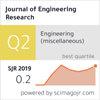Deformation control strategies for shield tunnel underpassing viaduct of high-speed railway: A case study
IF 0.9
4区 工程技术
Q3 ENGINEERING, MULTIDISCIPLINARY
引用次数: 0
Abstract
The impact of shield tunneling in close proximity to existing underground structures is a matter of great concern, especially in the construction of shield tunneling underpassing viaduct of high-speed railway. Improper handling of such situations can lead to a significant risk to the safety of these structures, thereby rendering construction activities particularly challenging. To effectively reduce these effects in the shield tunnel proximity construction, a comprehensive deformation control strategy of implementing isolation pile and steel lateral bracing after sleeve valve pipe grouting is proposed. The internal force and deformation characteristics of existing pile foundation groups are studied and compared with conventional reinforcement measures. The results show that grouting reinforcement and isolation pile reinforcement have limited effect, while the reinforcement efficiency of the comprehensive deformation control strategy exceeds 200%, which is more effective in controlling pile displacement and internal forces. Compared to no reinforcement, the maximum axial force and bending moment of existing pile foundations are reduced by 77% and 60%, respectively, while the maximum horizontal displacement and vertical settlement are reduced by 76% and 19%, respectively. The settlement of the cushion cap is 1.37 mm, which is verified through on-site construction, meeting the requirements for safe construction.
高速铁路盾构隧道下穿高架桥变形控制策略研究
盾构隧道在临近既有地下构筑物的情况下施工,特别是在高速铁路下穿高架桥的盾构隧道施工中,其对地下构筑物的影响受到了广泛关注。如果处理不当,可能会对这些结构的安全造成重大风险,从而使建筑活动特别具有挑战性。为有效降低盾构隧道近距离施工中这些影响,提出了套筒阀管灌浆后实施隔震桩+钢侧支的综合变形控制策略。对既有桩基群的内力和变形特性进行了研究,并与常规加固措施进行了比较。结果表明,注浆加固和隔震桩加固效果有限,而综合变形控制策略的加固效率超过200%,对桩身位移和内力的控制更为有效。与不加筋相比,既有桩基最大轴力和弯矩分别降低77%和60%,最大水平位移和竖向沉降分别降低76%和19%。垫帽沉降量1.37 mm,经现场施工验证,满足安全施工要求。
本文章由计算机程序翻译,如有差异,请以英文原文为准。
求助全文
约1分钟内获得全文
求助全文
来源期刊

Journal of Engineering Research
ENGINEERING, MULTIDISCIPLINARY-
CiteScore
1.60
自引率
10.00%
发文量
181
审稿时长
20 weeks
期刊介绍:
Journal of Engineering Research (JER) is a international, peer reviewed journal which publishes full length original research papers, reviews, case studies related to all areas of Engineering such as: Civil, Mechanical, Industrial, Electrical, Computer, Chemical, Petroleum, Aerospace, Architectural, Biomedical, Coastal, Environmental, Marine & Ocean, Metallurgical & Materials, software, Surveying, Systems and Manufacturing Engineering. In particular, JER focuses on innovative approaches and methods that contribute to solving the environmental and manufacturing problems, which exist primarily in the Arabian Gulf region and the Middle East countries. Kuwait University used to publish the Journal "Kuwait Journal of Science and Engineering" (ISSN: 1024-8684), which included Science and Engineering articles since 1974. In 2011 the decision was taken to split KJSE into two independent Journals - "Journal of Engineering Research "(JER) and "Kuwait Journal of Science" (KJS).
 求助内容:
求助内容: 应助结果提醒方式:
应助结果提醒方式:


